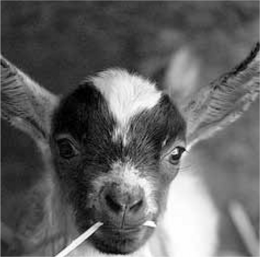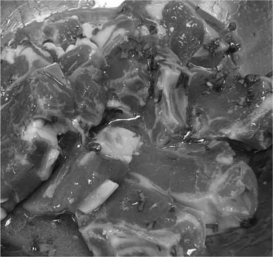

Although any goat may be used for meat, some people raise goats specifically for meat and have preferred breeds for doing so. As discussed in Chapter 2, meat goats will be of a larger build and will be more muscular and meaty than the dairy goat will be.
Goat meat is quite good and is the most consumed meat worldwide, eaten by nearly 70 percent of the population. It is lower in fat and cholesterol than beef, yet is higher in protein. The cuts are similar to lamb, yet goat meat is lower in calories than beef, chicken, pork, or lamb. And if you are raising them, you can put more meat goats on an acre of land that you can beef cattle.

This two-week old kid is an example of a cabrito goat.
According to the United States Department of Agriculture, the meatgoat industry is one of the fastest growing in the United States. As of 2008, there were more than 3 million meat goats in the United States, and that number continues to grow. One of the reasons for this is the rising immigrant population from cultures in which the primary meat is goat, which, in turn, is resulting in more Americans discovering the healthier benefits of goat meat. It is also a versatile meat, good for almost any use that the chef or home cook can put it to.
You will notice that goat meat is marketed in different ways. Chevon is meat from goats six to twelve months of age, while cabrito (meaning “kid”) comes from the young goat, usually anywhere from one to three months old and usually milk fed.
And although in the United States we usually think of sheep meat when we hear the word mutton, it is also used in reference to goat meat (chevon).
Some of the various cuts of goat meat include:
• Shank (lower leg)
• Ground meat (burger)
• Stew
• Chuck roast
• Rib rack
• Tenderloin
• Chops

Goat meat is considered a delicious staple in the majority of world cuisines.
Although some grocery stores may carry goat meat, it is more common (and preferable) to purchase it directly from the farm or a butcher.
When raising goats for meat, some owners who raise for their own meat prefer on-farm slaughter, even to the point of doing it themselves. This is less stressful on the goats as well as the owner, as they feel (and are usually correct) that they have full control and can make sure that the goat is slaughtered quickly and humanely. Should you choose on-farm slaughter, make sure that you learn the right way to do it. Nothing is more tragic than slaughtering an animal and not doing it properly. It can turn a well-meaning action into a cruel end of life for the animal.
If you don’t already know someone, then find someone who is proficient at home slaughter. Talk to them; ask them questions to make sure that they will teach you according to your standards. Ask if you can come and observe when they do one of their own. If their methods meet your expectations, then hire them. If they do things that you don’t like, or if you feel that they are not treating the animal respectfully, thank your host and move on to find someone who fits your needs.
What if you want on-farm slaughter to ensure that you control what goes on, but do not want to do the deed yourself? There are people who will come to your farm to perform slaughter and butchering. Many times, other livestock owners may know of someone who does this. If not, your local extension office may have information available on those who do on-farm slaughter. Just be sure that they know how to slaughter goats.
If you sell large numbers of meat goats, then sending the animals to a local slaughterhouse may be the way that you need to go. If you are not totally comfortable with sending your animals off of your farm for slaughter, don’t be afraid to actually interview the people at the slaughterhouse. Talk to some of their other clientele. If you want to be sure that the animals are being handled humanely and respectfully, ask if you can see the process. Again, if you like what you find out, hire them. If not, thank them and move on. On a side note, many times small, family-run slaughter and processing operations will offer what you will be looking for more reliably than larger-scale outfits.
You will probably find that the first time that you have your goats slaughtered, whether you do it yourself or send them out, will be difficult. Although saying it gets easier with time is not quite the right thing to say, you do get used to the fact that it is part of raising meat goats. And if you know your animals are being handled properly, humanely, and respectfully, it will make slaughter time a bit less stressful for all concerned.
A quick note: all states have their own rules and regulations on selling meat and dairy products. Should this be your goal, you need to check with your state’s regulations to find out what you will need to do.